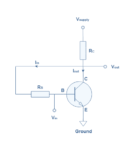

In order to avoid thermal runaway and the destruction of transistor, it is necessary to stabilize the operating point, i.e., to keep I C constant. The self-destruction of such an unstabilized transistor is known as Thermal run away. If the operating point is not stabilized, there occurs a cumulative effect which increases this heat dissipation. The flow of collector current and also the collector leakage current causes heat dissipation. Hence it is necessary to stabilize the operating point. Individual VariationsĪs the value of β and the value of V BE are not same for every transistor, whenever a transistor is replaced, the operating point tends to change. Therefore, the operating point needs to be stabilized i.e. To come out of this, the biasing conditions are set so that zero signal collector current I C = 1 mA. The collector leakage current I CBO is greatly influenced by temperature variations. Temperature Dependence of I CĪs the expression for collector current I C is Let us understand these concepts in detail. Stabilization of the operating point has to be achieved due to the following reasons. A good biasing circuit helps in the stabilization of operating point. Once the stabilization is achieved, the values of I C and V CE become independent of temperature variations or replacement of transistor. The process of making the operating point independent of temperature changes or variations in transistor parameters is known as Stabilization. To achieve this, biasing circuits are introduced. Hence operating point should be made independent of the temperature so as to achieve stability.

So the main problem which affects the operating point is temperature. V BE decreases by 2.5mv (for every 1 o rise).I CBO gets doubled (for every 10 o rise).The operating point shifts due to change in temperature.Īs temperature increases, the values of I CE, β, V BE gets affected. The main factor that affect the operating point is the temperature. Let us have a look at the factors that affect the stabilization of operating point.

The below figure shows a transistor amplifier that is provided with DC biasing on both input and output circuits.įor a transistor to be operated as a faithful amplifier, the operating point should be stabilized. The given DC voltage and currents are so chosen that the transistor remains in active region for entire input AC cycle. If appropriate DC voltages and currents are given through BJT by external sources, so that BJT operates in active region and superimpose the AC signals to be amplified, then this problem can be avoided. The BJT should be in the active region, to be operated as an amplifier. The input voltage should exceed cut-in voltage for the transistor to be ON. Because, for a BJT, to amplify a signal, two conditions have to be met. If a signal of very small voltage is given to the input of BJT, it cannot be amplified. The circuit which provides transistor biasing is called as Biasing Circuit. The proper flow of zero signal collector current and the maintenance of proper collectoremitter voltage during the passage of signal is known as Transistor Biasing. In the previous chapter, we explained how a transistor acts as a good amplifier, if both the input and output sections are biased. A transistor is based in order to make the emitter base junction forward biased and collector base junction reverse biased, so that it maintains in active region, to work as an amplifier. Emitter Follower & Darlington Amplifierīiasing is the process of providing DC voltage which helps in the functioning of the circuit.Transformer Coupled Class A Power Amplifier.


 0 kommentar(er)
0 kommentar(er)
